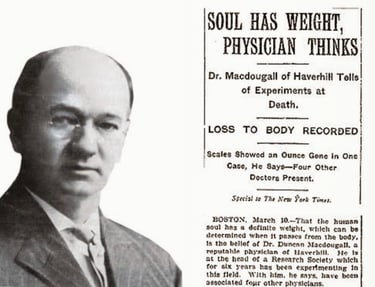21 Grams of Soul
"They" say a person's soul is their psyche; aka their inner energy, so to speak. So, for the sake of argument, it would be safe to assume that such a thing is weightless as it isn’t actual matter. However, in the early 20th century, a doctor weighed dying persons and came to the conclusion that a total of 21 grams disappeared 'inexplicably", from somewhere within these bodies. Though the theory was rejected by the medical industry, for some reason, there haven't been any other experiments to date. Clearly, they can make some calculations with brain waves or something that can "measure" (or weigh) electronic activity at the time of death...? Luckily, curious doctors still exist and I found her . . .
SOULSSPIRITSLIFE AFTER DEATHSUPERNATURAL
Illya Burke
3/2/20255 min read
Cite:
https://www.snopes.com/fact-check/weight-of-the-soul/
https://www.catholic.com/qa/difference-between-human-soul-and-spirit-2nd-use
https://whav.net/2014/06/28/haverhills-man-who-weighed-souls/
https://www.supernaturaltruth.com/body-soul-and-spirit
https://www.compellingtruth.org/difference-soul-spirit.html
https://www.irfi.org/articles/articles_151_200/islamic_concept_of_conscience.htm
https://medium.com/alternative-perspectives/did-you-know-your-soul-can-leave-your-body-while-youre-still-alive-a0220975951f
https://www.mcgill.ca/oss/article/did-you-know-general-science/story-behind-21-grams
https://www.theguardian.com/society/2024/apr/02/new-science-of-death-brain-activity-consciousness-near-death-experience


Can Dreams Measure the "Weight" of a Soul?
Though no modern experiments have attempted to weigh the soul, neuroscience has made strides in measuring brain activity at the moment of death. Some researchers have recorded surges in gamma waves, suggesting heightened consciousness even as the body shuts down. This raises an intriguing possibility: If our dream world is a function of our psyche, could the residual activity at death be the psyche detaching from its physical host? If so, could dreaming serve as a training ground for the soul's departure?
A Fully Managed Dreamscape:
By mastering dream control, we not only optimize our subconscious experiences but may also prepare ourselves for the final transition. Whether the soul truly weighs 21 grams is irrelevant—what matters is that, while we are alive, we have the ability to shape and manage our dreamscapes with intent. And if the afterlife turns out to be one long, unbroken lucid dream? At least we’ll have practice.



Let's put a spotlight on MacDougall's 21 Gram Theory: Fringe Science or Suppressed Experimentation?
The whole concept of the 21-gram theory, famously proposed by Dr. Duncan MacDougall who we now know is attributed to the initial debate regarding the nature of the soul and its potential weight. His experiments in Haverhill, Massachusetts, encountered skeptical criticism from the medical community since its inception.
He faced significant pushback from peers and institutions that were hesitant to endorse his findings. As documented in a WHAV article, those around him were reluctant to support research that could jeopardize funding opportunities. His colleagues even distanced themselves from the studies he conducted, which led to an overshadowed legacy. They deemed his methods questionable, arguing that he lacked sufficient evidence to draw definitive conclusions, particularly given the experimental conditions he employed but failing to include that they were namely the culprits oppressing his study.
Fast forward to the present day, nearly a century later, and advancements in our understanding of the dying process have emerged through the work of contemporary researchers like Sam Parnia and Jimo Borjigin. In 2006, Parnia, a leading expert on near-death experiences, along with Borjigin, began to explore brain activity at the point of death.
Their separate investigations aimed to uncover all the mysteries surrounding consciousness and the experiences reported during near-death situations. The findings have opened a new discourse about what occurs in the brain during the dying process and may lend credence to discussions initiated by MacDougall about the essence of life and death. An insightful take on this modern exploration can be found in a recent Guardian article, highlighting breakthroughs in understanding brain function at critical moments.




Adding another layer to the investigation of consciousness and death is the biological perspective on canines. MacDougall used dogs as well so here we go.. While humans have multiple sweat glands for cooling down, dogs primarily rely on panting due to the limited number of sweat glands located on their paw pads. This raises questions — are such physiological differences significant in the broader context of life, death, and potentially the existence of a soul? Examining theories like MacDougall’s, you have to consider how varying biological functions across species contribute to our understanding of consciousness and mortality.
From what is known, MacDougall’s 21-gram theory presents a fascinating glimpse into early endeavors to quantify the metaphysical. While he faced considerable resistance, the current wave of research on consciousness and dying challenges us to reflect on the inexplicable aspects of the human experience, rekindling discussions that some believed were extinguished long ago. Whether regarded as fringe science or an overlooked hypothesis, MacDougall's assertions compel us to explore the depths of our understanding about life, death, and everything in between.
The 21-Gram Mystery and the Management of Our Inner Most Space
In 1907, Dr. Duncan MacDougall attempted to weigh the human soul, concluding that upon death, a person loses precisely 21 grams. Though his methodology was riddled with errors and swiftly dismissed, the concept lingers in public imagination like a stubborn dream fragment. If the soul has mass—or at least some measurable presence—then could it be the entity responsible for managing our dreamscapes? Of course, "they" say the soul is our psyche—our inner energy. And if energy is neither created nor destroyed, then where does the "manager" of our dreamscape reside when we awaken? More importantly, can it be trained, like an underperforming employee, to follow a specific workflow? It damn sure can!
Distinguishing the Soul from the Spirit (And Why It Matters)
There is often confusion between souls and spirits, largely because the two have been used interchangeably across various religious and philosophical traditions. However, theological scholars and Meta physicists suggest that the soul is the essence of the individual—their personality, intellect, and will—while the spirit is the conduit connecting a person to the divine (or universal consciousness, depending on one's beliefs).
For the sake of our thesis, we'll entertain the following theories:
• The soul is the CEO of your dreamscape. It holds the unique identifiers of your subconscious mind.
• The spirit is the Wi-Fi signal. It connects you to something beyond yourself, but it is not the direct manager of your dreams.
• Your conscious mind is middle management. It believes it is in control, but really, it just takes orders from the deeper levels of your psyche.
Understanding this hierarchy is crucial if one wishes to navigate and control their dream world. The Mechanics of Dream Control: Training the CEO Dream control—also known as lucid dreaming— is the process of becoming aware that you are dreaming while inside the dream itself. Some individuals possess a natural ability to lucid dream, while others require extensive practice. Techniques include:
• Reality Checks: Asking yourself throughout the day, "Am I dreaming?" so that it becomes second nature within dreams.
• Dream Journaling: Documenting dreams immediately upon waking to increase subconscious awareness.
• Mnemonic Induction (MILD): Repeating affirmations before sleep (e.g., "I will realize I am dreaming").
• Wake-Back-to-Bed (WBTB): Waking up after several hours of sleep, staying awake briefly, then returning to sleep with the intent to dream consciously. If the soul is indeed the manager of the dreamscape, these techniques serve as performance reviews—gently nudging the CEO toward greater accountability.
Eclectic Occultist
G8WAY intellectual property found herein is branded as such and most graphic interchange formats along with all links lead to external businesses not owned or operated by G8WAY. If you own any image included here and wish to request its removal or proper attribution, please contact admin@g8way.online and G8WAY will respond promptly. Please note: a page’s presence in G8WAY does not imply it is complete. Each entry is a living document that may be subjected to editorial corrections and/or additions. G8WAY may earn a commission when users make a purchase through links posted throughout this site. Information on WWW.G8WAY.ONLINE is for informational purposes only and should not be considered professional advice. Thank You for Visiting! G8WAY.ONLINE ©2025 All rights reserved.


